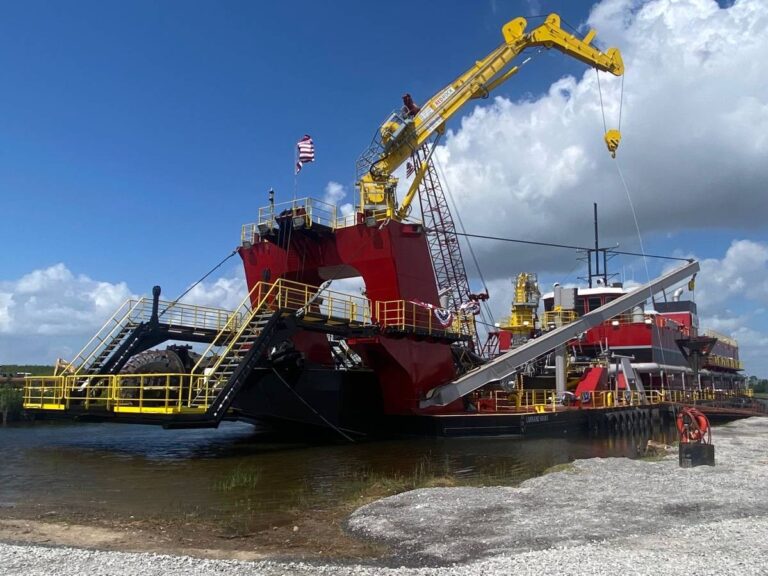Fierce Bidding Wars, Cost Savings, and Environmental Impact Shape the Dynamic Landscape of America’s Federal Dredging Market
The U.S. dredging industry is experiencing robust growth and intense competition, as highlighted in The Mike Hooks Report, a comprehensive analysis of the latest trends in the U.S. federal dredging market. Annually, the U.S. Army Corps of Engineers collaborates with American Maritime to identify and execute dredging projects spanning the nation’s inland waterways, coastal channels, ports, and harbors. The efforts of dredgers have successfully relocated over 200 million cubic meters of material from federal projects, enhancing the capacity of America’s ports and rivers to accommodate various vessels such as containerships, tankers, towboats, and other vital marine traffic.
The Mike Hooks Report: Insights and Analysis
In a noteworthy development, The Lorraine Hooks, owned and operated by Mike Hooks, LLC, has joined the U.S. dredging fleet, intensifying competition for new projects. To secure contracts for this crucial work, dredging companies engage in competitive bidding to efficiently deliver services on behalf of the American people. “The Mike Hooks Report: An Analysis of the FY22 U.S. Federal Dredging Market,” authored by Michael Gerhardt, Senior Director of Government Affairs at Mike Hooks, LLC, offers an insightful overview of the U.S. dredging industry and emphasizes the cost savings achieved by American Maritime for taxpayers.
In fiscal year 2022, a total of fifty-two Jones Act dredging companies secured federal dredging contracts, with a significant portion being awarded to small American businesses over the past decade. This indicates a thriving and competitive marketplace where numerous companies actively compete for government projects. Notably, 72% of the contracts saw winning bids from the private sector industry that were lower than the Independent Government Estimate, resulting in substantial savings of $670 million for the federal government and American taxpayers in fiscal year 2022 alone.
William Doyle, CEO & Executive Director of Dredging Contractors of America, attributes these cost efficiencies to the intense competition among companies bidding for projects. He emphasizes the innovation-driven nature of these companies, with teams of professionals dedicated to finding better ways to execute tasks and gain a competitive edge. Dredging awards being public knowledge allows unsuccessful bidders to learn from the experience and be better prepared for future opportunities.
The impact of this competition is evident in the statistics, with fifty-nine projects coming in under budget by more than 10%, 27 projects costing over 25% less than expected, and 15 projects achieving budget reductions of over 40%. These figures underscore the cost-effectiveness of the U.S. dredging industry, a critical component of the 650,000 individuals working in American maritime.
Environmental Impact: Utilization of Dredged Material
The trend of using dredged material for environmental purposes is gaining traction nationwide. Rather than disposing of excavated dredged material at sea, there is an increasing emphasis on utilizing it for initiatives such as rebuilding islands in the Chesapeake Bay, coastal restoration in the Carolinas, and dike rehabilitation along the Mississippi River and the Gulf Coast.
Dredging has particularly gained renewed importance on the Gulf Coast, where states like Louisiana benefit significantly from the economic impact of the Jones Act. Congressman Clay Higgins of Louisiana’s 3rd Congressional District emphasizes the prioritization of dredging and proper maintenance of water management systems to support vital economic engines like ports and waterways.
American Maritime is actively contributing to environmental projects, such as the State of Louisiana’s marsh creation project at Lake Borgne, where beneficial dredged materials are being reused to rebuild fragile marshes along the coast. Led by Mike Hooks, LLC, this initiative aims to protect local communities from storm surges.
The consistent awarding of contracts for such projects has led to a $2.5 billion recapitalization spree within America’s dredging sector, resulting in the construction and deployment of newly built dredges and expanding the Jones Act fleet. This strategic growth underscores the industry’s commitment to meeting evolving demands and contributing to the nation’s maritime infrastructure.
